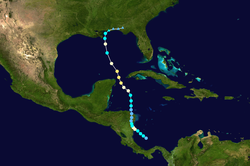Hurricane Ida (2009)
Hurricane Ida was the last storm in the 2009 Atlantic hurricane season. It formed in the southwestern Caribbean on November 4 after being in that area for a few days. After becoming a depression it quickly got stronger and became a tropical storm and a hurricane shortly before it struck Nicaragua. Over Central America, Hurricane Ida weakened very fast, becoming downgraded to a tropical depression before the end of the day on November 5.
| Category 2 hurricane (SSHWS/NWS) | |
 Hurricane Ida near peak intensity on November 8 | |
| Formed | November 4, 2009 |
|---|---|
| Dissipated | November 10, 2009 |
| Highest winds | 1-minute sustained: 105 mph (165 km/h) |
| Lowest pressure | 975 mbar (hPa); 28.79 inHg |
| Fatalities | 4 direct |
| Damage | $11.9 million (2009 USD) |
| Areas affected | Nicaragua, Honduras, El Salvador, western Cuba, Yucatan Peninsula, Louisiana, Mississippi, Alabama, Florida Panhandle, Georgia |
| Part of the 2009 Atlantic hurricane season | |
By November 6, Ida went back into the Caribbean and later became a hurricane again. Its strength changed a few times before it died on November 10 off the coast of Alabama. Reports show that Hurricane Ida caused $5.6 million in damage and caused 2 deaths.
Storm history
Ida was tracked back to a tropical wave that entered the western Caribbean Sea on November 1. A low soon formed near the tropical wave. This low did not move very much and it also got a lot of clouds near the middle of it. There was hardly any wind shear, which allowed for more clouds to form. [1]
On November 4, the tropical wave National Hurricane Center began call it Tropical Depression Eleven. [2] The new tropical depression quickly got stronger and became Tropical Storm Ida soon after that. [3] An Aircraft went into Ida and soon found winds at 65 miles per hour, which meant it was nearly a hurricane. [4]
Continuing to the northwest, Tropical Storm Ida was upgraded to Hurricane Ida when winds got to 80 miles per hour; [1] at the time, it was put at only 75 miles per hour. [5] Soon after this, Hurricane Ida made landfall in Nicaragua on November 5. [1] Ida weakened quickly over land and was downgraded to a tropical storm just after landfall. [6] Near the end of the day on November 5, Tropical Storm Ida weakened to a tropical depression. [7]
Tropical Depression Ida survived its passage over land and went back into the Caribbean on November 6. [1] Over the western Caribbean, it quickly became a tropical storm again. [8] After moving north, Tropical Storm Ida became a hurricane again. [9] It reached its highest winds on November 8 while it crossed between Cuba and Mexico; they were measured at 105 miles per hour, making it a category 2 hurricane. [1] Water temperatures in the Gulf of Mexico were not warm enough to keep Ida at this strength. so it quickly weakened back to a tropical storm. [10]
For only six hours, it became a hurricane again before it became extratropical on November 10 while it was just south of Alabama.[1] At the time, it looked like it stayed as a tropical storm and made landfall in Alabama, [11] this was later noted as incorrect. [1] Its remnants formed a strong nor'easter that affected some of the states of the East Coast of the United States.
Impact
Damage in Nicaragua was near $2.1 million and there were no people killed. In El Salvador, it seemed at first that killed over 100 people, this was discovered as a mistake later on.
Hurricane Ida (2009) Media
Satellite animation of Hurricane Ida moving from the northern Caribbean Sea into the Gulf of Mexico
Conditions at Pensacola Beach, Florida on November 9
Related pages
Reference
- ↑ 1.0 1.1 1.2 1.3 1.4 1.5 1.6 Avila and Cangialosi (January 14, 2010). "Hurricane Ida Tropical Cyclone Report" (PDF). National Hurricane Center. Retrieved January 17, 2010.
- ↑ Eric Blake and James Franklin (November 4, 2009). "Tropical Depression Eleven Public Advisory One". National Hurricane Center. Retrieved November 11, 2009.
- ↑ Eric Blake and James Franklin (November 4, 2009). "Tropical Depression Eleven Discussion One". National Hurricane Center. Retrieved November 11, 2009.
- ↑ Richard Pasch and David Roberts (November 4, 2009). "Tropical Storm Ida Tropical Cyclone Update". National Hurricane Center. Retrieved November 11, 2009.
- ↑ Brennan, Brown, and Blake (November 5, 2009). "Hurricane Ida Advisory 4A". National Hurricane Center. Retrieved 15 February 2010.
{{cite web}}: CS1 maint: multiple names: authors list (link) - ↑ Brown and Blake (November 5, 2009). "Tropical Storm Ida Advisory 5A". National Hurricane Center. Retrieved 15 February 2010.
- ↑ Pasch and Roberts (November 5, 2009). "Tropical Depression Ida Advisory 7". National Hurricane Center. Retrieved 15 February 2010.
- ↑ Brennan, Michael (November 7, 2009). "Hurricane Ida Advisory 7". National Hurricane Center. Retrieved 15 February 2010.
- ↑ Brennan and Kimberlain (November 7, 2009). "Hurricane Ida Tropical Cyclone Update". National Hurricane Center. Retrieved 15 February 2010.
- ↑ Franklin, James (November 9, 2009). "Tropical Storm Ida Advisory 23". National Hurricane Center. Retrieved 15 February 2010.
- ↑ Brennan, Black, and Cangialosi (November 10, 2009). "Tropical Storm Ida Advisory 26A". National Hurricane Center. Retrieved 15 February 2010.
{{cite web}}: CS1 maint: multiple names: authors list (link)






